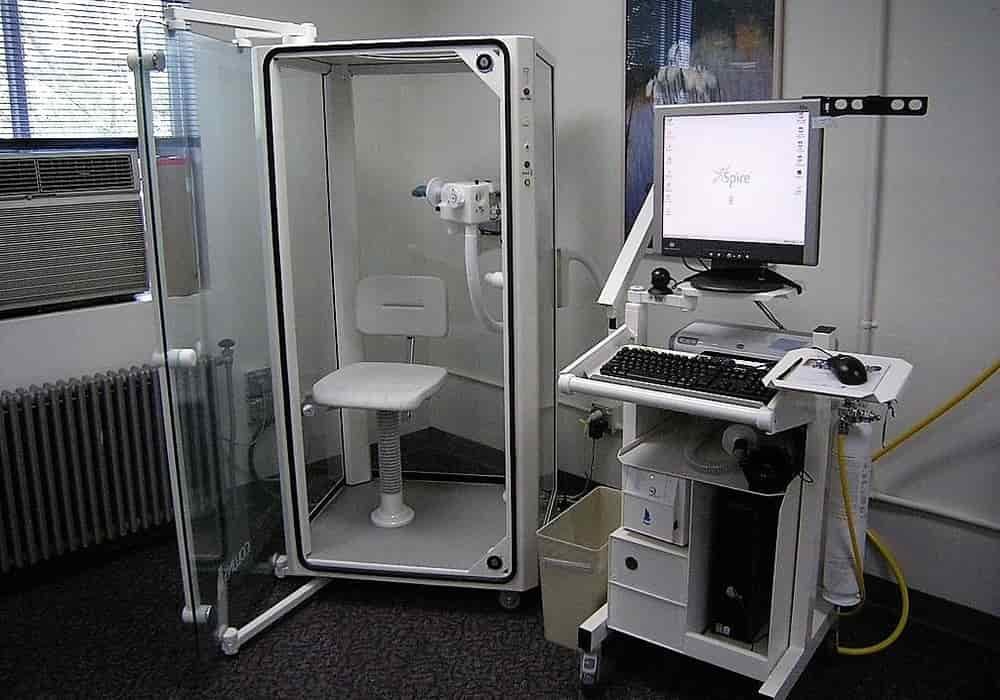Spirometry
Spirometry is the most reliable way to test your lungs and check if you have COPD (chronic obstructive pulmonary disease) and asthma. Your doctor may call spirometry by another name, such as “lung function test” or “respiratory function test”.
The test is performed with the aid of an instrument called a spirometer. The graph that the spirometer prints represents on the vertical axis (the ordinate) the volume of the air flow ( Litter / second ) and as a function of time on the horizontal axis (the abscissa).
Why is spirometry important?
Spirometry can help diagnose and manage various types of lung disease. If you have any questions or concerns about your lung health, talk to your doctor about spirometry.
The earlier the spirometry is done, the earlier lung disease can be detected and treated. There are several treatments available to reduce symptoms, prevent lung disease from getting worse, reduce flare-ups (exacerbations), and improve your daily life.
Who should take a spirometry test?
People with asthma
Spirometry is an important diagnostic and management tool for people with asthma. If you have asthma and have never had a spirometry test, talk to your doctor.
Smokers and ex-smokers
If you are over 40 and a smoker or ex-smoker, you may have COPD. Take this test to check if you have symptoms of COPD.
Read also: Oximeter | How does it work? What is Normal Range of Blood Oxygen Level?
How is the spirometry test performed?
Spirometry is a painless test that can often be done at your doctor’s office or at a clinic near you. The full test takes less than 10 minutes, but is sometimes repeated after a dose of inhaled medicine.
You will be asked to breathe into a mouthpiece, wearing a nose clip. The technician will show you how to breathe in as deeply as possible. You will breathe out as hard as you can, until your lungs are completely empty. You might then be asked to take a deep breath again. You will repeat these steps three or more times, for best results. You may also be given medicine to inhale; the test will then be repeated to see if your lungs have responded to the medicine.
How to prepare for the test:
- Do not smoke an hour before the test
- Do not drink alcohol four hours before the test
- Do not eat a heavy meal two hours before the test
- Wear loose clothing
- Do not exercise vigorously 30 minutes before the test
- If you use medicine pumps, you may be asked not to use them for a few hours before the test. Ask your doctor (or service provider) in advance if this applies to you.
What does spirometry measure?
Spirometry tells your doctor if your lungs are functioning normally. It provides various measurements of respiration, the most common of which are:
- Forced Vital Capacity (FVC) – The maximum amount of air you can breathe out after inhaling as deeply as possible.
- Maximum expiratory volume (FEV1) – The amount of air you can breathe out of your lungs in the first second.
- If you’ve been diagnosed with asthma or COPD in the past, spirometry can help check if your treatment is working.
- If the amount of air you breathe out in the first second is low, you may have a lung disease such as asthma or COPD.
Be good to your lungs. Talk to your doctor about spirometry.
Forced Expiratory Volume and Forced Vital Capacity
Forced expiratory volume (FEV) measures how much air a person can exhale during a forced breath. The amount of air exhaled may be measured during the first (FEV1), second (FEV2), and/or third seconds (FEV3) of the forced breath.
Forced vital capacity (FVC) is the total amount of air exhaled during the FEV test.
Forced expiratory volume and forced vital capacity are lung function tests that are measured during spirometry. Forced expiratory volume is the most important measurement of lung function. It is used to:
- Diagnose obstructive lung diseases such as asthma and chronic obstructive pulmonary disease (COPD). A person who has asthma or COPD has a lower FEV1 result than a healthy person.
- See how well medicines used to improve breathing are working.
- Check if lung disease is getting worse. Decreases in the FEV1 value might mean the lung disease is getting worse.
Information: Cleverly Smart is not a substitute for a doctor. Always consult a doctor to treat your health condition.
Sources: PinterPandai, NHS UK, Mayo Clinic, American Lung Association
Foto credit: Author: Joe Mabel / Wikimedia Commons (CC BY-SA 3.0)
Title: Chamber used for Body Plethysmography and other related medical tests. Photographed at Swedish Hospital Ballard Campus, Seattle, Washington. File: Body Plethysmography chamber 01.jpg
Author’s homepage: http://joemabel.com/art.html
Photo description: device for spirometry (left). The patient places his or her lips around the blue mouthpiece. The teeth go between the nubs and the shield, and the lips go over the shield. A noseclip guarantees that breath will flow only through the mouth. Screen for spirometry readouts at right. The chamber can also be used for body plethysmography.



